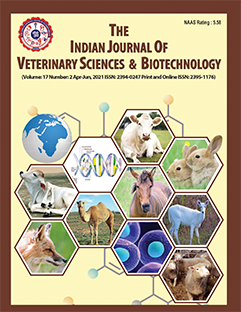Viral Pathogens, Risk Factors and Spatial Clustering of Porcine Respiratory Disease Complex in Hassan District of Karnataka State, India
DOI:
https://doi.org/10.48165/ijvsbt.21.3.08Keywords:
Hassan, PRDC, Risk factors,, Seroprevalence, Spatial clustering.Abstract
A pilot study was conducted to identify the prevailing viral agents associated with porcine respiratory disease complex, probable risk factors and spatial clustering of these pathogens in Hassan district. A total of 225 blood samples were collected randomly from 27 different pig farms of the district. The detection of antibodies for viral pathogens like Porcine Circovirus 2 (PCV 2), Porcine Parvovirus (PPV), Classical Swine Fever Virus (CSFV) and Porcine Reproductive and Respiratory Syndrome Virus (PRRSV) was done using commercial ELISA kits. An overall of 31.11 % samples were positive for viral co-seropositivity. The farm prevalence of viral co-seropositivity was found to be 64 %. Among the co-seropositive samples, PPV and PCV 2 antibodies were found in 97.14 % and 94.28 %, respectively and were appeared as dominant viral pathogens. The risk factors like large farm size, poor ventilation, movement of pigs between the pens, exchange of live pigs between the farms, feedback type of feeding, visitors movements, inadequate watering, location of nearby farms, high farm density, etc., were significantly influencing the higher occurrence of PRDC in the district. The analysis of spatial pattern of PRDC in the district revealed no clustering of infection.
Downloads
References
Alawneh, J.I., Parke, C.R., Lapuz, E.J., David, J.E., Basinang, V.G., Baluyut A.S., Barnes, T.S., Villar, E.C., Lopez, M.L., Meers, J., & Blackall, P.J. (2018). Prevalence and risk factors associated with gross pulmonary lesions in slaughtered pigs in smallholder and commercial farms in two provinces in the Philippines. Frontier in Veterinary Science, 5, 1-7.
Bernardo, T.M., Dohoo, I.R., & Donald, A. (1990). Effect of ascariasis and respiratory diseases on growth rates in swine. Canadian Journal of Veterinary Research, 54, 278-284.
Bhat, P., Singh, N.D., Leishangthem, G.D., Kaur, A., Mahajan, V., Banga, H.S., Filia, G., & Brar, R.S. (2018). Seroprevalence of
respiratory diseases of swine population in Punjab. Haryana Veterinarian, 57(1), 48-50.
Bochev, I. (2007). Porcine respiratory disease complex (PRDC): A review. I. Etiology, epidemiology, clinical Forms and pathoanatomical features. Bulgarian Journal of Veterinary Medicine, 10(3), 131-146.
Constable, P.D., Hinchcliff, K.W., Done, S.H., & Grünberg, W. (2017). Veterinary Medicine: A textbook of the diseases of cattle, horses, sheep, pigs, and goats. 11th ed., Elsevier Ltd. Publication. pp. 2308;
Dione, M., Masembe, C., Akol, J., Amia, W., Kungu, J., Lee, H.S., & Wieland, B. (2018). The importance of on-farm biosecurity: Sero-prevalence and risk factors of bacterial and viral pathogens in smallholder pig systems in Uganda. Acta Tropica, 187, 214-221.
Fablet, C., Marois-Cre´Han, C., Simon, G., Grasland, B., Jestin, A., Kobisch, M., Madec, F., & Rose, N. (2012). Infectious agents associated with respiratory diseases in 125 farrow-to-finish pig herds: A cross-sectional study. Veterinary Microbiology, 157, 152-163.
Foreyt, W.J. (2001). Veterinary Parasitology Reference Manual. 5th ed., Blackwell Publishing. State Avenue Iowa, 50014. pp. 235. Hurnik, D., Dohoo, I.R., & Bate, L.A. (1994). Types of farm management as risk factors for swine respiratory disease. Preventive Veterinary Medicine, 20, 147-157.
Indian Livestock Census Report. (2019). Ministry of fisheries, Animal Husbandry and dairying. Department of Animal Husbandry and Dairying, Government of India. Krishi Bhavan, New Delhi. pp. 130.
Li, P., Liu, L, Liu P.J., Guo, B., Yang, F., Fang, H.J., & Zhu, L. (2016). An investigation of pathogens associated with porcine respiratory disease complex and interactions analysis in Sichuan. Food Hygiene, Agriculture and Animal Science Downloaded from www.worldscientific.com by Monash University on 18/11/19.
Lo´ Pez-Soria, S., Maldonado, J., Riera, P., Nofrari´As, M., Espinal, A., Valero, O, Blanchard, P., Jestin, A., Casal, J., Domingo, M., Artigas, C., & Segale, S.J. (2010). Selected swine viral pathogens in indoor pigs in Spain. Seroprevalence and farm
level characteristics. Transboundary and Emerging Diseases, 57, 171-179.
Przyborowska-Zhalniarovich, P., Zhalniarovich, Y., & Wasowicz, K. (2021). Estimation of the prevalence of respiratory diseases in pigs in north-eastern Poland: Survey of pulmonary lesions in pigs at a slaughterhouse. Veterinarni Medicina, 66(6), 242-247.
Qin, S., Ruan, W., Yue, H., Tang, C., Zhou, K., & Zhang, B. (2018). Viral communities associated with porcine respiratory disease complex in intensive commercial farms in Sichuan province, China. Scientific Reports, 8, 13341.
Ramachandra, T.V., Kamakshi, G., & Shruthi, B.V. (2004). Bio resource status in Karnataka. Renewable and Sustainable Energy Reviews, 8, 1-47.
Satheesha, S.P., Bhat, M.N., Hiremath, J.B., Upendra, H.A., Ramesh P.T., Rathnamma, R., Narayanaswamy, M., & Veena, R. ( 2020). Copro-prevalence of endoparasites in domestic pigs (Sus Scrofa) and associated risk factors in different pig farms of Hassan district, Karnataka. Journal of Entomology and Zoological Studies, 8(6), 667-673.
Schmidt, C., Cibulski, S.P., Andrade, C.P., Teixeira ,T.F., Varela A.P.M., Scheffer, C., Franco, A.C., De Almeida, L.L., & Roehe, P.M. (2016). Swine influenza virus and association with the porcine respiratory disease complex in pig farms in southern Brazil. Zoonoses and Public Health, p. 1-7. https://doi.org/10.1111/
zph.12223.
Stärk, K.D.C. (2000). Epidemiological investigation of the influence of environmental risk factors on respiratory diseases in swine - A literature review. Veterinary Journal, 159, 37-56.
Thomas, R., Singh, V., & Gupta, V.K., 2021. Current status and development prospects of India’s pig industry. Indian Journal of Animal Sciences, 91(4), 255-268.
Tregaskis, P.L., Staines, A., Gordon, A., Sheridan, P., Mcmenamy, M., Duffy C.P.J., Collins, P.J., Mooney, M.H., & Lemon, K. (2020). Co-infection status of novel parvovirus’s (PPV2 to 4) with Porcine Circovirus 2 in porcine respiratory disease complex and porcine circovirus-associated disease from 1997-2012. Tranboundary Emerging Diseases, p. 1-16.
White, M. (2011). Porcine respiratory disease complex (PRDC): Part 2: Non-infectious factors. Livestock, 16, 44-46.
Downloads
Published
Issue
Section
License
Copyright (c) 2025 Indian Journal of Veterinary Sciences and Biotechnology

This work is licensed under a Creative Commons Attribution-NonCommercial-NoDerivatives 4.0 International License.




